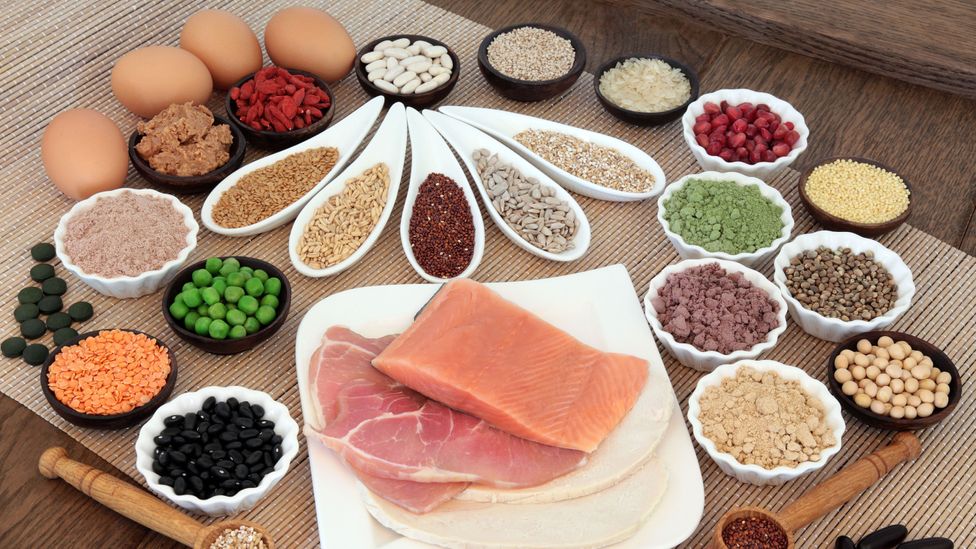Posts Tagged with “Nutritional Supplements”
The Best Foods for Lung Health

Add these foods to your diet to keep your lungs healthy and strong.
When it comes to lung health, you’ve probably heard the usual advice: avoid (or quit) smoking, stay away from highly polluted areas, and exercise regularly. However, you may not realize that eating the right foods is also an excellent way to support healthy lung function.
Like the rest of your body, your lungs benefit from a balanced diet full of essential nutrients, vitamins, and minerals. However, there are also some particularly effective foods that can help protect your lung health and reduce the risk or symptoms of lung diseases such as asthma and chronic obstructive pulmonary disease.
Below are the top seven foods for lung health, including key nutrients you should include in your diet if you want to boost lung function and prevent disease.
How does diet affect lung health?
One way diet affects lung health is through inflammation. Certain foods—like refined carbohydrates, soda, and red meat—cause inflammation in the body, which is linked to the development of many health conditions, including COPD and other lung diseases. By eating an anti-inflammatory diet rich in fruits, vegetables, fiber, and healthy fats, you can reduce inflammation and maintain healthy organs.
Take a quick quiz about what you’re looking for in a food delivery service and we’ll share our top picks. We may receive a commission when you make a purchase through our links.
Some specific foods have also been linked to healthier lungs in research. For example, fruits like apples and tomatoes contain high levels of antioxidants, which according to one study may help with lung function. Similarly, eating foods rich in fiber (such as lentils and beans) is also associated with better lung health.
In addition to eating nutritiously, there are several other ways to protect your lungs from disease and toxins, including:
Not smoking or vaping (or quitting if you currently use nicotine)
Avoid exposure to polluted air or secondhand smoke
Stay physically active
Adherence to health and hygiene recommendations, including hand washing and keeping up to date with dental care and vaccinations
7 Foods That Benefit Your Lungs
Generally speaking, eating a well-balanced and nutritious diet is an excellent way to take care of your lungs. Here are seven lung-healthy foods you can incorporate into your diet today.
apples
Apples – especially the skin of apples – contain an antioxidant called quercetin, which has been shown to reduce inflammation in the lungs and help people living with lung diseases such as COPD. In addition, eating apples and other fruits (including bananas and tomatoes) has been found to help prevent lung function decline, especially in people who used to smoke.
Peppers
Red peppers and chili peppers have high concentrations of vitamin C, another key antioxidant that promotes better lung health and reduces inflammation. Getting the recommended daily amount of vitamin C is important for everyone, but it’s especially important if you smoke because smokers have lower levels of vitamin C than non-smokers.
Beet
Beets, a brightly colored root vegetable, are packed with dietary nitrates. When consumed, your body converts these nitrates into nitric oxide, which helps relax blood vessels, increases oxygen flow, and lowers blood pressure—all of which help improve lung function. Beets also contain antioxidants and anti-inflammatory properties.
Leafy vegetables
Green leafy vegetables like Swiss chard, kale, and spinach contain a variety of antioxidants (including vitamin C and carotenoids) that help fight inflammation. Even better? Eating enough carotenoids – which are also present in tomatoes, peppers, and many fruits – is associated with a lower risk of lung cancer.
Legumes
Legumes such as beans, peas, and lentils are high in fiber, which in one study was found to improve lung function. Another study found that fiber consumption had a “protective effect” on the lungs of both smokers and non-smokers, helping to reduce the prevalence of COPD.
Tomatoes
Tomatoes and tomato-based products (including tomato juice) are fantastic sources of vitamin C and lycopene, another type of carotenoid antioxidant that reduces inflammation in the airways. Lycopene may also offer a reduced risk of death in people with COPD.
Berry
Deeply colored berries such as blueberries, strawberries, and blackberries are rich in anthocyanins, antioxidants from the flavonoid group. Anthocyanins have numerous benefits, including reducing mucus and inflammation in the lungs, as well as the potential to slow age-related decline in lung function.
Conclusion
Keeping your lungs in good shape is vital to your overall health. By eating a diet that’s rich in antioxidants, fiber, and other lung-strengthening nutrients mentioned above, you’ll have a better chance of preventing lung disease and illness—at least from a nutritional standpoint.
In addition to eating right, you can keep your lungs as healthy as possible by exercising your body regularly. If you have a chronic illness, tracking your key health indicators (in addition to seeing your doctor) is a great way to stay on top of your lung health and overall well-being.
Could Eating More Protein Reduce Obesity Risk? New Study Suggests It Can

Could Eating More Protein Reduce Obesity Risk? New Study Suggests It Can
Could eating more protein reduce the risk of obesity? A new study suggests it can
If you find yourself eating less-than-ideal snacks or packing in calories later in the day, you may just not be craving more food. According to a new study, your body may actually need protein.
The study, which was published in the journal Obesity, included an analysis of data from the National Nutrition and Physical Activity Survey, which ran from May 2011 to June 2012. Taking into account the dietary and physical habits of 9,341 adults with an average age of 46.3 years, researchers from the University of Sydney found that participants’ dietary energy intake generally consisted of 30.9% fat, 43.5% carbohydrate, 18.4% protein, 4.3% alcohol and 2.2% fiber.

Those behind the study also found that participants who didn’t eat as much protein during breakfast (or their first meal of the day) ate more during the rest of the day than participants who ate more protein earlier. High-protein breakfast eaters also ended up eating less as the day went on.
The researchers also found that participants who didn’t eat enough protein at the start of the day not only ended up eating more calories throughout the day, but also ate more foods high in fat, sugar, and salt; consumed more alcohol; and ate less healthy foods such as grains, vegetables, legumes, fruits, dairy products, and meat.
The researchers found that one of the reasons why the study participants did not consume enough protein was likely to be a high intake of processed foods. This high intake of low-quality processed foods crowds out protein foods that promote satiety, limit overconsumption of calorie-poor, nutrient-poor foods, and reduce the risk of obesity.
“It’s becoming increasingly clear that our bodies eat to satisfy a protein target,” Professor David Raubenheimer, head of the Leonard Ullmann Chair in Nutritional Ecology in the School of Life and Environmental Sciences and one of the study’s authors, said in a statement to EurekAlert! “But the problem is that the food in the Western diet has less and less protein. So you have to eat more of it to reach your protein goal, which effectively increases your daily energy intake.”
Lead author Dr. Amanda Grech, a postdoctoral fellow at the University of Sydney’s Charles Perkins Center and the University’s School of Life and Environmental Sciences, also noted: “As people eat more junk food or highly processed and refined foods, they dilute their protein diets and increase their risk of overweight and obesity, which, as we know, increases the risk of chronic disease.”
When you eat this, not that! I spoke with Kylene Bogden, RD, co-founder of FWDfuel, Pureboost ambassador, and Cleveland Cavalier’s nutritionist, she told us she wasn’t surprised by the results.

“These findings are incredibly accurate,” says Bogden. “Many of us consume processed foods multiple times a day, day in and day out, which leads to chronic inflammation and nutrient deficiencies. When our bodies are chronically inflamed and deficient, we can experience fatigue, intense sugar cravings, and lethargy.” lose weight.”
As for how high-protein, high-fat, and high-carb foods affect your body differently, as well as why the latter two can potentially lead to obesity, Bogden notes that “just breaking down protein burns the most calories, fat is in second place. and carbohydrates come in third.” He says that “part of this slower digestion process is that adequate protein intake is essential for optimal blood sugar control, and stable blood sugar makes weight loss a smoother process.”

Save up to 70% on Bath & Beauty products at eVitamins
Save up to 70% on Bath & Beauty products at eVitamins | Coupons Markets
Save up to 70% on Bath & Beauty products at eVitamins | Coupons Markets
4 Ways to Determine the Acidity of Water
4 Ways to Determine the Acidity of Water
To begin with, it’s important to remember that reverse osmosis water is somewhat acidic, which isn’t a major deal. You must, however, be comfortable with this method. In this article, we’ll go over a couple of methods for testing the acidity of your filtered water. Let’s learn more.

pH Test Strips
Dip a pH strip in the water, and the change in colour will indicate whether the water is acidic or alkaline. We recommend that you get anything that will assist you attain a reading of 5.5 to 8.5. Getting an acid strip with two broad readings is not a smart idea because it will be difficult to distinguish between the hues.
Litmus Paper is a type of test paper.
A pH strip and Litmus paper have a lot in common in terms of functionality. The only difference is that the accuracy of a Litmus paper is lower. If the water is alkaline or acidic, these strips will tell you. Reverse osmosis water is a mild acid in general. It may not even be able to identify if the water is acidic depending on the Litmus paper type.
Testing Center in the Area

You can also contact your local water testing authority for assistance. You can send a sample of water to these labs for a thorough examination. These service providers will give you with significantly more accurate findings.
Cabbage (Red)
You can also do a test with red cabbage. Because red cabbage has a pigment that changes colour depending on the pH level of water, it may be used to easily test your tap water. Simply combine a slice of cabbage with some water. The fact that the water turns red indicates that the sample is acidic.

Is it true that RO filters make water more acidic?
If you filter away alkaline minerals, you’ll end up with slightly acidic water, which is quite natural. In fact, regardless of the type of filter, you will obtain the same outcomes. The water will not dissolve since it is slightly acidic.
FAQs
What causes RO water to be acidic?
Because the reverse osmosis equipment removes alkaline minerals from the water, the acidity level rises. However, you do not need to be concerned because the acidity level is really low. Lemon juice and tomato sauce, on the other hand, have a much greater acidity level.
Is RO water acidic or alkaline?
Water from a reverse osmosis system has a pH of 6.5.
Is it necessary to remineralizer RO water?
Remineralization is an option for compensating for the acidity of water. You don’t have to do it, though, if you don’t want to. Experts say that even without remineralization, reverse osmosis water is safe to drink on a regular basis.
Is it true that RO water lowers vitamin D levels?
The vitamin D levels in your body will not be increased or decreased if you consume reverse osmosis water on a daily basis. The problem is that this filtration process removes certain minerals, such as calcium. However, this reduction will have no effect on your body’s intake.
Is it possible for RO water to eliminate minerals from your body?
No. The reverse osmosis (RO) technology eliminates salts from your tap water. Drinking this type of water, on the other hand, will not deplete your body’s minerals.
So, to determine if your water is alkaline or acidic, try one of these four approaches.




